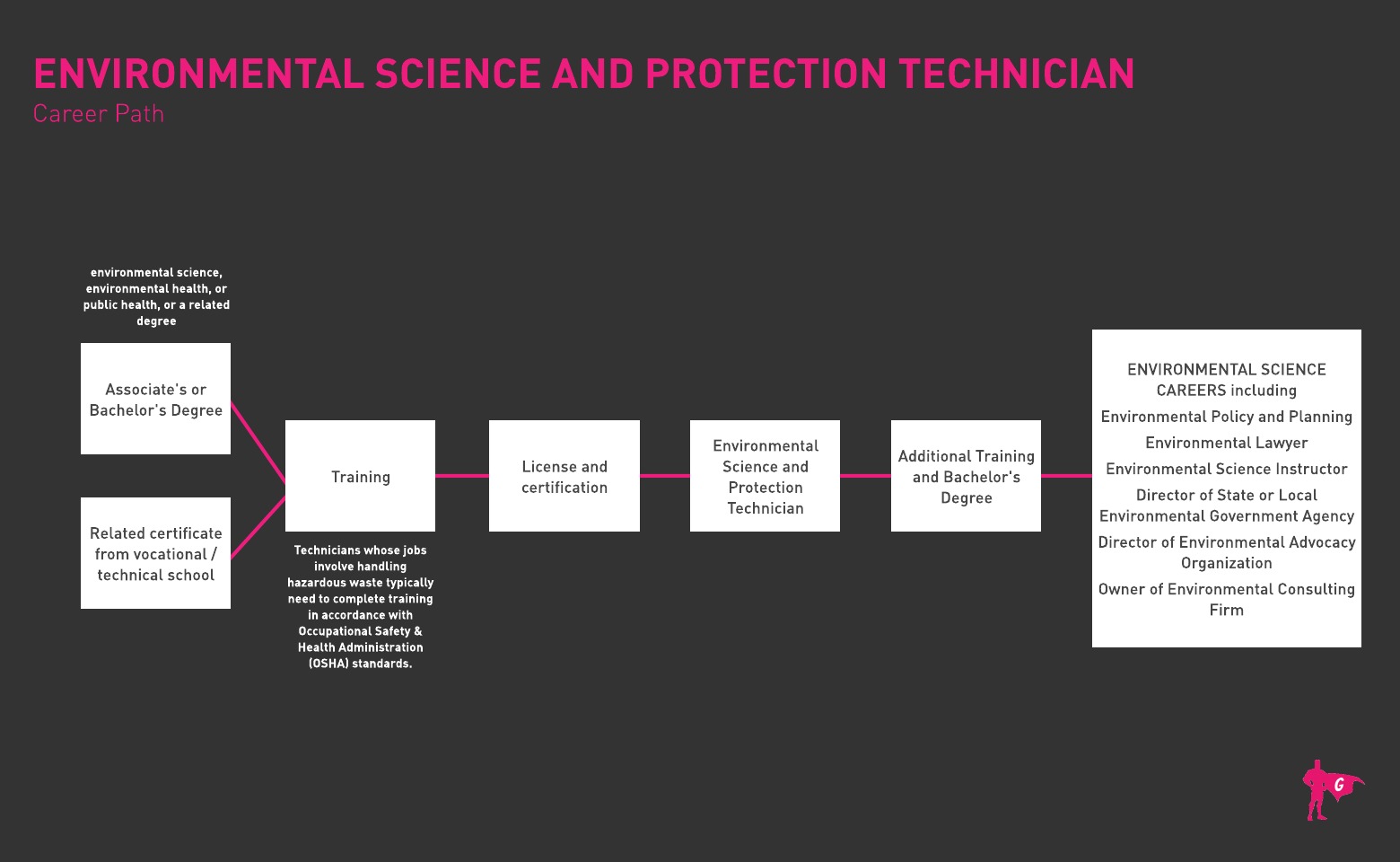聚光灯
相似标题
环境科学技术员、环境保护技术员、环境技术员、健康环境科学与保护技术员、环境专家、环境现场技术员、公共卫生防疫员、防疫员、水质分析员、水质专家、污染控制技术员、环保工作者
职位描述
环境科学与保护技术人员负责观察自然环境,并探究污染源。他们常采集土壤、水体及气体样本进行检测。这类专业人员通常专攻野外作业或实验室工作,但也能胜任两种环境下的工作。
职业生涯的回报
- 知道你正在对环境产生积极影响
- 以拥有“绿色”工作为荣
- 紧跟影响我们世界的最新环境议题
- 在保障人们安全方面发挥着重要作用
- 在一天中执行多种不同类型的任务
- 与那些关心人类福祉和环境的人们携手合作
内幕消息
工作职责
- 设置设备以监测污染水平和排放量
- 采集土壤、水和空气样本进行检测
- 检查企业及公共场所是否存在环境、健康或安全隐患
- 利用数据制作报告,汇总测试结果,并与各方进行讨论。
- 确保组织遵守防止污染的法规
- 设计用于监测污染或辐射对环境影响的程序
- 调查食物中毒/疾病爆发或危险泄漏/状况,以收集数据进行分析
环境科学与保护技术员的工作日常可能涉及办公室、实验室或野外作业。他们与各类专业人士协作,包括环境科学家与专家、工程师、地球科学家、水文学家以及其他领域的技术人员。
工作中所需技能
通用技能
- 分析能力
- 沟通技巧
- 批判性思维
- 人际交往能力
- 积极倾听
- 阅读理解与口语能力
- 科学背景
技术技能
- 分析或科学软件
- 计算机辅助设计(CAD)软件
- 电子邮件软件
- 企业资源规划(ERP)软件
- 地图制作软件
不同类型的组织
- 州或地方政府
- 咨询公司
- 检测实验室
期望与牺牲
对于该领域的某些专业人士而言,日常工作会受到天气的显著影响。当户外采样和数据收集条件适宜时,可能需要延长工作时间。愿意在各种条件下工作并灵活应对日程变动,将有助于从业者晋升至更高职位。
当前趋势
- 增加可再生能源来源
- 降低能耗
- 推广再生农业
- 加大塑料回收利用和生物降解产品的使用力度
- 处理人类排泄物管理
- 更优的气候变化应对措施
- 遏制水泥碳排放
- 提升航空旅行的能源效率与环保性
从事这个职业的人年轻时喜欢做什么……
- 喜欢户外活动和动手实践
- 喜欢科学,并研究他们感兴趣的课题
- 对环境、植物和动物充满好奇
- 对地球的福祉怀有强烈关切,并渴望为世界带来改变
所需的教育和培训
- 初级环境科学与保护技术人员至少应持有环境科学、环境健康、公共卫生或相关领域的副学士学位。多数从业者拥有学士学位,而硕士学位则可使你获得更高的起始职位。
- 美国职业信息网络(O*Net)指出,该领域从业人员中14%持有副学士学位,55%持有学士学位,14%持有硕士学位。
- 常见的必修课程包括化学、生物学、地质学、物理学、数学、统计学和计算机科学。学生还需具备实验室实践经验,并学习遥感技术与地理信息系统知识。
- 处理有害废物的环境科学与保护技术人员需接受职业安全与健康管理局的相关培训,内容包括识别健康危害及在危害环境中安全作业、正确使用个人防护装备以及适用情况下的去污规程。
- 认证及其他培训选项包括:
- 董事会认证环境专业人员学院 - 认证环境专业人员
- 认证野生动物康复师
- 美国生态学会 - 认证生态学家
- 可持续性研究所——美国化学工程师学会可持续性专业人员认证
- 国际可持续发展专业人士协会 - 可持续发展卓越助理
- 美国国家环境卫生协会 - 注册环境卫生专家/注册卫生员
- 国家氡安全委员会 - 氡测量技术员
- 国家环境专业人员注册名录 - 助理环境专业人员
- 国家野生动物联合会 - 生态领袖
- OSHA认证环境专家
- 美国林学会 - 候选注册林学家
- 野生动物协会 - 助理野生动物生物学家
高中与大学期间的必做之事
- 选修环境科学、健康科学、生物学、数学、化学、工程学、传播学、地理学和计算机技术等课程。
- 自愿参与河流清理项目、高速公路认养计划或其他环保项目,以获取实践经验。
- 参与校园活动,在与他人协作、解决问题并达成预定目标的过程中,锻炼项目管理能力、人际交往能力、领导力、团队合作精神及冲突解决能力。
- 考虑你希望在何处工作。该行业的许多技术人员受雇于咨询公司、州或地方政府机构,或在测试实验室工作。某些岗位比其他岗位需要更多实地工作。
典型路线图

如何获得你的第一份工作
- 环境科学与保护技术人员拥有广泛的教育和培训机会。部分院校及项目与招聘人员保持紧密合作,这些招聘人员正致力于吸纳毕业生加入。
- 同时,请向学校的就业指导中心寻求简历修改和模拟面试方面的帮助。
- 与您所在地区共同参与志愿活动的人交流。他们可能熟悉当地的就业机会。
- 查看Indeed上的环境科学与保护技术员实习岗位空缺
- 参加您所在地区的招聘会,并携带简历副本。
- 在Indeed、Simply Hired、Glassdoor、Google for Jobs和Zippia等求职平台注册职位提醒服务。
- 在领英及其他社交平台上发布您的求职信息
- 请求与在职专业人士进行信息性面试,以获取求职建议
- 部分州对环境科学与保护技术员的需求高于平均水平。就业岗位最集中的州依次为西弗吉尼亚州、阿拉斯加州、新墨西哥州、怀俄明州和佛罗里达州。
- 请提前询问您的教授、主管和同事是否愿意担任您的个人推荐人。
- 查阅环境科学与保护技术员简历模板以获取灵感
- 研究环境科学与保护技术员的面试问题以备面试。准备好回答关于《有毒物质控制法》、《清洁水法》和《清洁空气法》等法律的深入问题。
- 面试时务必着装得体,面试结束后务必记录所问问题。
推荐资源
备选方案
这些职位的职责与环境科学与保护技术员相似:
- 农业与食品科学技术人员
- 生物技术员
- 化学技术员
- 临床检验技师和技术员
- 环境工程技术人员
- 环境科学家和专家
- 法医科学技术人员
- 地质样品测试技术员与地球科学家
- 水文学家
- 环境合规检查员
- 大地测量师
- 水土保持工作者
忠告
根据预期增长率、薪资水平、失业率、压力程度、工作与生活平衡度等综合因素,《美国新闻与世界报道》2020年"最佳科学职业"榜单中,环境科学与保护类岗位位列第三。对于热衷探索自然世界并希望为未来创造积极影响的人士而言,环境科学与保护领域堪称理想的职业选择。
新闻源

精选职位

在线课程与工具

薪资与就业前景
选择子区域:
年薪预期
新员工起薪约为5.1万美元。年薪中位数为6.2万美元。经验丰富的员工年薪可达7.7万美元左右。
来源:加利福尼亚州就业发展部
年薪预期
新员工起薪约为5.2万美元。年薪中位数为5.5万美元。经验丰富的员工年薪可达6.8万美元左右。
来源:加利福尼亚州就业发展部
年薪预期
新员工起薪约为4.9万美元。年薪中位数为5.9万美元。经验丰富的员工年薪可达7.8万美元左右。
来源:加利福尼亚州就业发展部
年薪预期
新员工起薪约为5.2万美元。年薪中位数为6万美元。经验丰富的员工年薪可达8万美元左右。
来源:加利福尼亚州就业发展部







